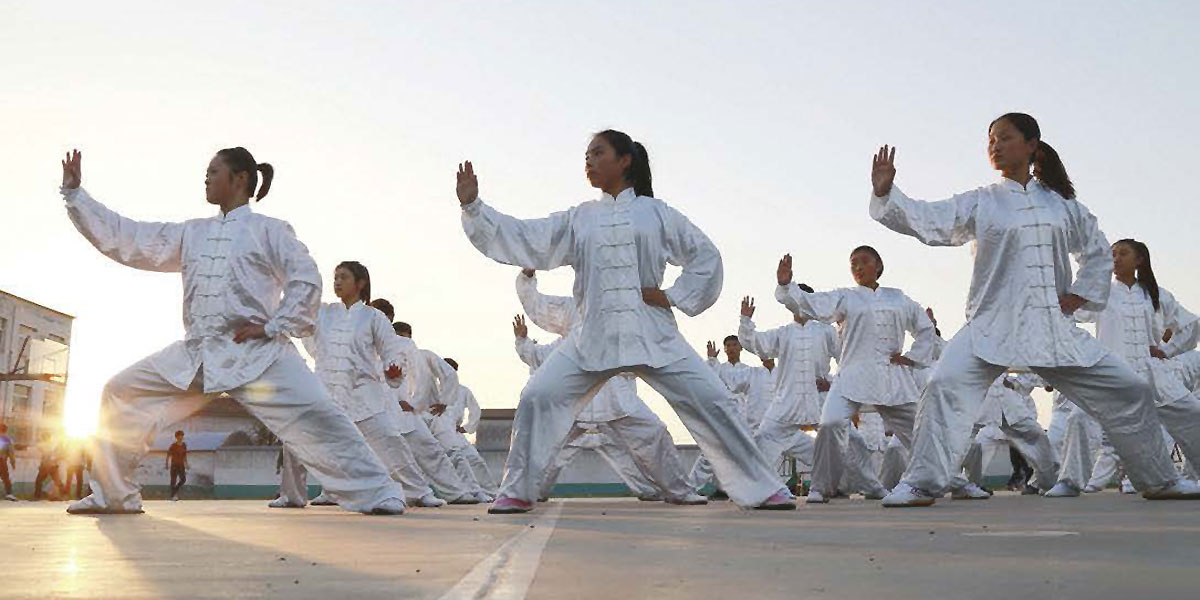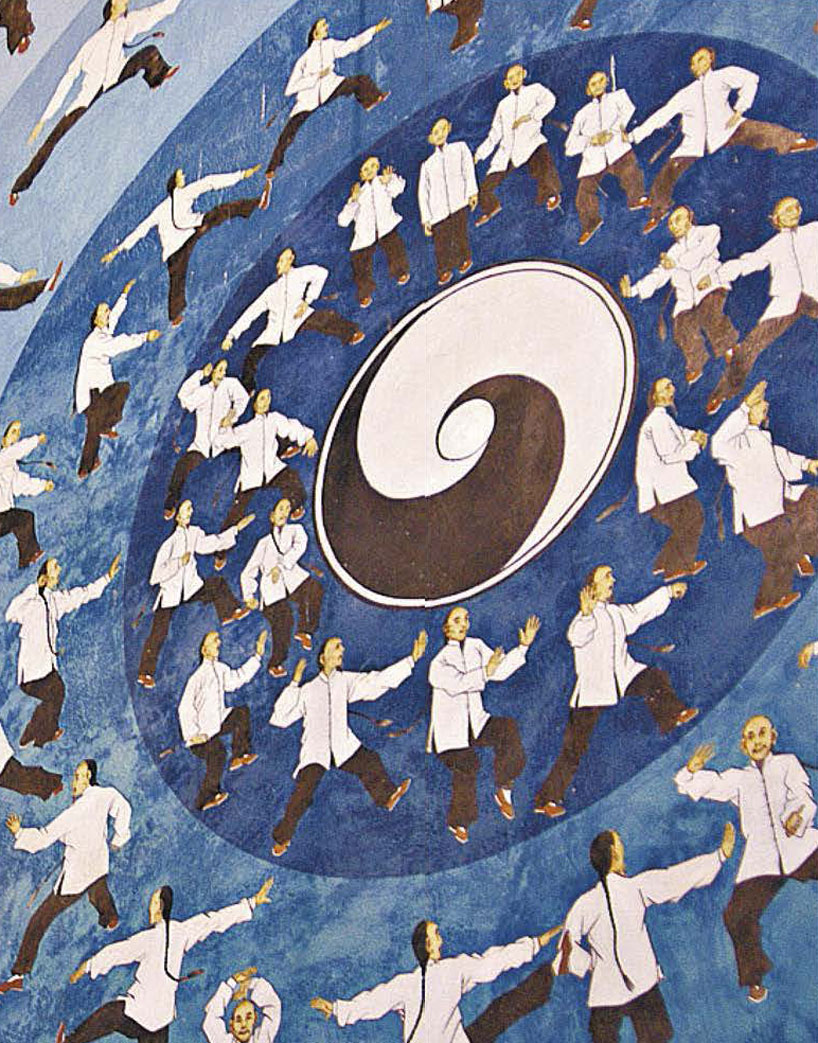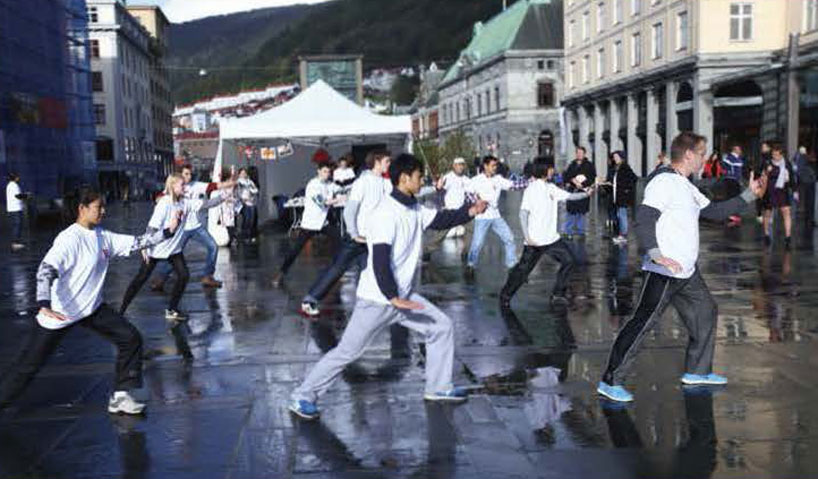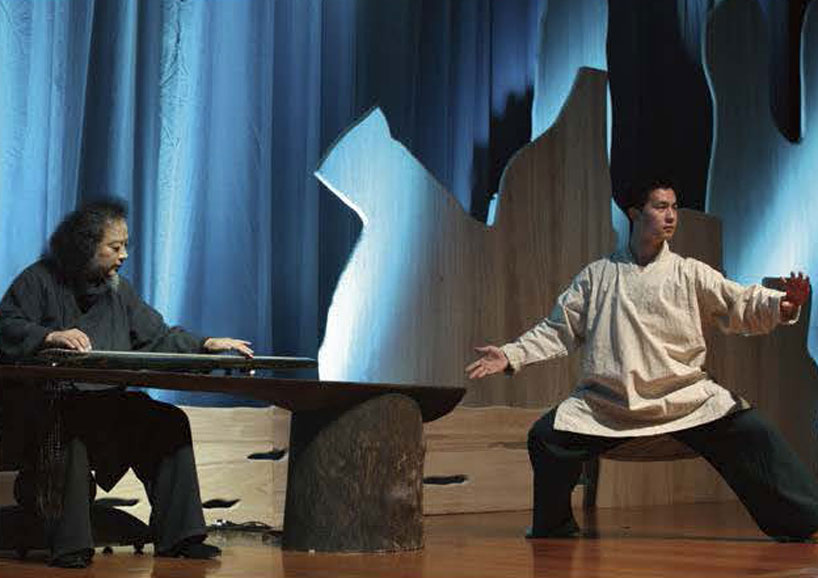

The recreational philosophy of t’ai chi ch’uan
There are currently more than 120 million people practising t’ai chi worldwide, with the Chinese accounting for the vast majority. This martial art, which has been passed down for many generations, will help clear up your discomfort and awaken the natural balance between body and mind.
It’s 7 am in Beijing. Mr Zhang gets up at his usual time. He puts on his white training outfit, washes his face and heads out.
At 7:15 the music starts to ring in the neighbourhood square. “Begin!’’the leader shouts, and all the members get into their stances.
Mr Zhang stands in the last row as usual. He cannot yet remember all the moves, and finds it easier to follow the others from behind.
With no verbal commands being given, the team moves with surprising unison. This training programme of t’ai chi ch’uan, literally ‘great ultimate fist or boxing’, consists of slow but smooth moves, and lasts for half an hour. After that, everyone looks calm and relaxed. Mr Zhang has been sweating a little. He takes several deep breaths and gently pats his cheeks, feeling an extreme clarity in both mind and body. After a little chat with his team, Mr Zhang, humming a merry little tune, goes to buy breakfast for his family. Another beautiful new day, starting with t’ai chi ch’uan, has just begun.
Keeping body and mind in natural balance and harmony
“T’ai chi ch’uan can make you more perceptive to things around you. As a result you will find that even simple things, such as the cool breeze or chirping of a cicada, are actually very enjoyable,” Mr Zhang says with a smile. “I used to think that the most relaxing thing to do was to sink into the sofa and watch TV. Now I realize that taking a break does not necessarily mean doing nothing, but instead finding a way to stay calm and relaxed. By simply lifting your hands you have started the engine of t’ai chi. Focus your mind solely on every movement of your body, bending down,facing upward, moving forward and backward, and you will feel as if you are connecting with the sky and the earth.”
If you visit a park or a neighbourhood in almost any city in China, you can see people practising t’ai chi. According to an estimate by the World Health Organization, there are currently more than 120 million people practising t’ai chi worldwide, with the Chinese accounting for the vast majority. The best part of the day is in the morning, as the old saying goes. The Chinese believe that a pleasant morning leads to a fulfilling day. As the birds begin to twitter in the morning, people put on loose and comfortable clothing and practise this form of traditional martial arts. This martial art, which has been passed down for many generations, will help clear up your discomfort and awaken the natural balance between body and mind.

At first, Mr Zhang bought a DVD and began to practise t’ai chi by following the teaching programme on the video. “After awhile I felt a pain in my knees and thought about giving it up. Later I found out that it was because I had used too much force when practising,”he said. The art of t’ai chi is all about relaxation. Every move should be smooth and relaxing. “If you feel tension then you must have done it wrong.”
Later on, a t’ai chi team was formed among his neighbours who came to share their experience and help each other make progress.Soon the team members became close friends. “This really improves the atmosphere of the neighbourhood.Before the residents of the same building did not have the chance to meet and talk to each other, but now there are no strangers among the neighbours.”
Many people compare t’ai chi with yoga from India.
On May 15, 2015, more than 400 people from China and India who love either t’ai chi or yoga gathered in Beijing’s Temple of Heaven in order to exchange ideas and make friends. Their performances included a rich mixture of moves, either forceful or gentle, but each in its own way achieving a great sense of agility and peace. Though different in form, both t’ai chi and yoga help people seek integration with nature and maintain health through physical training combined with internal power.
“Yoga is too difficult for people like us who are getting old.You need to have a muscular physique for it,” says Mr Zhang.“Well, unlike yoga, t’ai chi can be done by anybody anytime and anywhere. Man or woman,old or young, and they can practise it whenever they like.”
An American life insurance company did an investigation,and found that the premium rate usually goes down if the insured had practised t’ai chi. Research institutes such as the Tufts Medical Centre in Boston proved through experiments that the practice of t’ai chi can improve physical and mental health. It brings about a welcome change in cognition and mood, which often leads to an increase in the number and proportion of immune cells in the body, and this will help people live longer and feel happier.
Mr Zhang believes that the practice of t’ai chi is actually a practice of qi ‘life energy’, the primeval force vital to all life on earth. In the Kung Fu Panda movies, qi is shown to have amazing power to help withering flowers to bloom again, and even cure illness.
“It’s difficult to put it into words. It feels like you have the awesome internal power that the kung fu masters in the novels usually have,” says Mr Zhang.
Floating cloud and flowing water: a metaphor shared by t’ai chi and guqin
Every weekend a group of t’ai chi enthusiasts gather in the Beijing Olympic Forest Park. Li Hui is one of them. Unlike Mr Zhang,Li learns t’ai chi because it helps him with his guqin, an ancient seven-string Chinese zither instrument.
“My guqin teacher suggested that I learn t’ai chi because guqin and t’ai chi follow the same patterns in the manipulation of qi and the application of force.” Hold your head up in a relaxed way, stand firmly on the ground like a deep-rooted tree,relax your neck and shoulders,and move your hands with the strength from the muscles in your waist. This is the standard pattern in the practice of t’ai chi, which helps increase the internal force and mental power that you need to accomplish a master piece of the guqin. “After practising t’ai chi for a long period time you will feel it has rhythm, too.”
Typical Chinese recreations,such as the practice of the guqin, calligraphy, drawing, tea ceremony, meditation and t’ai chi, seem to belong to different disciplines and have little in common with each other. However, in fact they embrace the same Chinese philosophies and offer similar physical and mental benefits.
“Zen meditation and tea ceremony follow the same principle, so do playing the guqin and practising t’ai chi,” says my guqin teacher.“They adopt the same philosophy,differing from one another only in the form of expression.”
In his book The Lore of the Chinese Lute (1), Robert Hans van Gulik, a well-known sinologist, wrote: “When, borne on the unworldly and serene tones of the lute, the mind of the player is purified and elevated to mystic heights, his soul may commune with the essence of the rugged rocks and vast stretches of water confronting him, and so he may experience a complete reunion with tao.”

Within the context of traditional Chinese philosophy, tao signifies the natural way of the universe. Human beings are intended to follow the principles of nature and find their true selves through meditation. The concept of t’ai chi carries similar ideas: in the boundless universe, out of wu ‘nonexistence’came you ‘existence’, and out of t’ai chi evolved yin‘darkness’and yang ‘brightness’, which are both opposed to one another and complement one another, and give rise to all things in the world. The practice of t’ai chi ch’uan is actually a demonstration of changes taking place any time and anywhere in the universe, in the hope of seeking balance between yin and yang, and a peaceful relationship between man and nature. People often feel stressed and busy in the fast lane of urban life. As a beneficial and convenient form of recreation, t’ai chi is becoming popular and well-received by more and more people.
“No one can say that he now completely understands the meaning of t’ai chi,” says Li Hui. “But that’s the beauty of it. The practice of t’ai chi ch’uan helps bring about a state of mental calm and clarity. With each move and posture, you will perceive changes in space and time, meditate on yourself,and obtain energy from nature.”
Preserving cultural heritage:sharing the beauty of one another
Many people go to the village of Chenjiagou in Henan, to learn t’ai chi ch’uan from a master. This place nurtures excellent t’ai chi practitioners and is thus widely accepted as the shrine oft’ai chi ch’uan. It is said that even the young children there can do it remarkably decently. There once was a well known entrepreneur who came to the village to learn it from a t’ai chi master.Afterwards he included the practice of t’ai chi ch’uan in his staff training programme. Even when recruiting new people, they asked the applicants to practise t’ai chi as part of the interview.Their skills along with their inner quality they show, would make or break their interview.
Historical studies show that Chenjiagouis one of the birth lands of t’ai chi ch’uan. From the Chen style the Yáng, Wu, Wú and Sūn styles are derived,and routines of 24, 48 and 102 moves have been developed. Practitioners of the different styles learn from each other, and form their own way of practicing. As a tradition, t’ai chi ch’uan is passed down from the master to his students. The master is a figure of authority, and the students must follow closely to the master’s instructions.
Gao Chong, who is learning t’ai chi ch’uan at Beijing Sport University,has his own understanding of this martial art. “The teaching of t’ai chi ch’uan needs to be adjusted to the different needs of the learners. In order to promote the development of t’ai chi and improve its skills we should learn from other disciplines.”In his opinion it’s not practical for everyone to go to the mountain and stay there for deep meditation, especially for people living among the noise and nuisance of urban life. The practice of t’ai chi can be an effective and realistic alternative. In order to allow more people to know about t’ai chi, we should establish a new mode of t’ai chi enterprise, promoting it as a new kind of modern life style.
Now that he has graduated, Mr Gao works at a recreation training centre, teaching the aged to practise t’ai chi. His students really love this form of exercise, and some ladies in their 60s come from far away by subway for class. “They make the practice of t’ai chi a part of their daily routine. When going back home after class they practise it again and again in front of the mirror.” Mr Gao believes that recreation centres, like the one he works for, lower the threshold for learning t’ai chi. They meet the recreation needs of people leading a modern urban life.
Wang Li, a teacher from Beijing Sport University, has brought t’ai chi to Bergen, Norway. At the Confucius Institute there he teaches t’ai chi, and it is very popular among the locals of all ages.
“Beyond my expectations, the westerners not only accept t’ai chi as a form of recreation, but they also long for more knowledge about its nature and philosophy,” says Wang. “This presents a big challenge for the Confucius Institute teachers. Even if all the students are Chinese, it’s not an easy thing to do.”
Now t’ai chi is a welcome course at more than 500 Confucius Institutes and 1,000 Confucius Classrooms.It has been reported that the Medical Centre at Harvard University will promote t’ai chi as a training exercise for health maintenance. And in Canada,sport experts have called t’ai chi a“perfect form of sport”.
Among the students who come to the Confucius Institute in Bergen for t’ai chi, a great number of them have already learned some of its moves.Now they are learning more things from Wang’s class. “My students say that they not only learned about the moves but also the nature of t’ai chi,”Wang says contentedly. “This means that I have managed to make them understand the essence of t’ai chi.”
Sophie was once taught by teacher sat this Confucius Institute. She has loved sports since she was a child. She has played football, handball and hockey. However, while in secondary school she was suddenly plagued by severe headaches, which stopped her from doing any sports. Upon her friends’ recommendation, she began to learn t’ai chi ch’uan from the teachers of the Confucius Institute. “I had no interest in it before and could not bear its slow movements. But I have been fascinated with it ever since I began to learn it.” Sophie was amazed at the magical effects of t’ai chi. “After practising for a period of time, my heart rate was lowered and even my headaches were not as bad as before.” Later,this Norwegian girl came to Beijing to continue her study of t’ai chi at Beijing Sport University. T’ai chi, this great cultural heritage, has been preserved and promoted by people like Wang Li and Sophie who have made a success story about communication and continuation.
“Start work at daybreak and retire at sunset. Enjoy life and keep a state of mental calm and clarity.” This verbatim quotation from Zhuangzi, one of the two foundational texts of Daoism, is also a classical depiction of t’ai chi. One move brings you to the mental state of t’ai chi in which beautiful sceneries begin to form in your mind. Life is just like the moves of t’ai chi ch’uan ,simple, repetitive, subtle and easygoing.
Note:
(1): This is van Gulik’s translation of the Chinese word gupin.





























 Published in
Published in
No hay comentarios:
Publicar un comentario